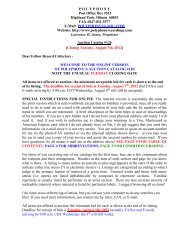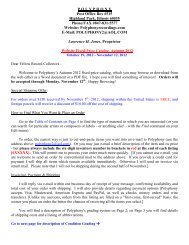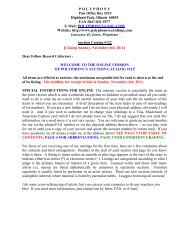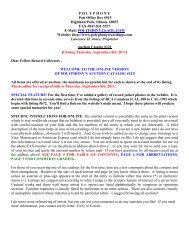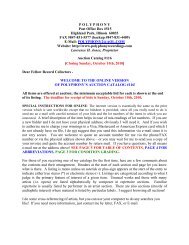831 – 5577 E – Mail - Polyphony Recordings
831 – 5577 E – Mail - Polyphony Recordings
831 – 5577 E – Mail - Polyphony Recordings
You also want an ePaper? Increase the reach of your titles
YUMPU automatically turns print PDFs into web optimized ePapers that Google loves.
Condition Grading<br />
Grading used records is difficult since a subjective element is always present and variations in<br />
equipment will cause differences in sound. My method: each disc is examined visually to note<br />
marks which may be audible. Such defects are auditioned and, in any case, each record is spotchecked<br />
in several places on both sides for surface noise and other defects which are not visible.<br />
Records are then graded by as follows:<br />
FS - Factory-sealed<br />
A - Records in the general category of A are in excellent condition. A<br />
record graded A- will be virtually perfect, but may have an occasional very light tick or<br />
slight noise in quiet passages: A- is my typical grade for a domestically-pressed disc which<br />
appears mint; it corresponds to the oft-used term "near-mint;" "A- to A" is used for the best<br />
foreign pressings and occasionally for unusually fine American ones.<br />
B - Records in the general category of B are in good condition. They will<br />
have no serious scratches and will not suffer from breakup of the musical sound. A record<br />
graded B+ will have no scratches and only minor surface noise. A grade of B or B-<br />
indicates greater degrees of noise and may also involve light blemishes or scratches, but<br />
the degree of defect will not impair enjoyment of the music to a great extent.<br />
C - These records are in fair condition. They will be playable, but noisy.<br />
D - These records are in poor condition; perhaps unplayable.<br />
If isolated portions of a disc sound worse than the grade indicates, specific flaws are noted in<br />
detail. A slash mark between grades indicates differences between sections of the disc, generally<br />
between sides. Mono discs are graded with the amplifier in mono mode.<br />
Please bear two things in mind about my grading: First, because it is based on audition (rather<br />
than only visual inspection) it tells you not only how a record looks, but how it sounds: it is a<br />
rating not only of how well the record has been cared for but how well it was pressed to begin<br />
with. Second, the grade is assigned without regard for a record's age. A disc pressed in the<br />
1950's and graded B+ is probably an excellent or mint copy of a typical pressing from that era. I<br />
try to be conservative in my grading, but if you receive a record which you feel is in condition<br />
inferior to its grade, you may return it within two weeks for full refund of its cost.<br />
Happy Browsing!!!<br />
-- Larry Jones



